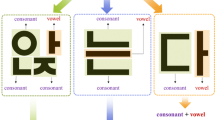Abstract
Smartphones are becoming more advanced, and the use of touch input is increasing. Therefore, various keyboards can be implemented in smartphones. Unlike the button input method, the touch input method can have non-fixed keys that can be freely arranged. Many users are thus interested in the touch input method. In this paper, we propose a Korean grapheme model called ‘Auto Toggle’ by using auto switching between consonants and vowels of Hangul. Also, Auto Toggle is designed and implemented based on the Android platform. Finally, we describe the results of a performance evaluation for the number of buttons pushed for each single syllable of Hangul compared with conventional methods. Additionally, Auto Toggle results in a rapid improvement on typing speed with respect to sentence generation.


















Similar content being viewed by others
References
Lim, Y.-W., & Lim, H. (2011). A design of Korean input method using direction of vowel on the touch screen. Journal of Korea Multimedia Society, 14(7), 849–963.
Kang, S.-S., & Hahn, K.-S. (2004). Basic vowel set for Hangul input system. In Korea institute of information scientists and engineers fall conference papers (Vol. 31). No. 2.
http://graynote.tistory.com/entry/mobilephone-grapheme-standardization-strategy.
Shtykh, R. Y., & Jin, Q. (2011). A Human-centric integrated approach to web information search and sharing. Human-Centric Computing and Information Sciences, 1, 2.
Obaidat, M. S., & Zarai, F. (2012). Novel algorithm for secured mobility and IP traceability for WLAN networks. Journal of Convergence, 3(2), 1–8.
Tarhini, C., & Chahed, T. (2012). QoS-oriented resource allocation for streaming flows in IEEE802.16e mobile WiMAX. Telecommunication Systems, 51(1), 65–71.
Znaidi, W., & Minier, M. (2012). Key establishment and management for WSNs. Telecommunication Systems, 50(2), 113–125.
Agboma, F., & Liotta, A. (2012). Quality of experience management in mobile content delivery systems. Telecommunication Systems, 49(1), 85–98.
Berl, A., & de Meer, H. (2011). Integrating mobile cellular devices into popular peer-to-peer systems. Telecommunication Systems, 48(1–2), 173–184.
Kim, M.-J., & Yun, J.-H. (2010). Functional analysis and design of mobile game user interface. Journal of the Korea Contents Association, 10(1), 138–140.
Hwang, S.-J., Kim, S.-T., Park, Y.-W., & Lim, C.-Y. (2010). Development and evaluation of multi-touch based Korean inputting system. In HCI conference, 573–575.
Oh, H.-Y. (2007). Soft keyboard interface design for mobile device. Journal of the Korea Contents Association, 7(6), 79–88.
Budiu, R., & Nielsen, J. (2009). Usability of mobile websites (pp. 44–48). Fremont: Nielsen Norman Group.
Zhang, J., Patel, V. L., Johnson, K. A., Malin, J., & Smith, J. W. (2002). Designing human-centered distributed information systems. IEEE Intelligent Systems, 17(5), 42–43.
Park, H. H. (2009). Design and implementation of applicable Hangul input method for touch–UI cube input method. Master degree, Sung-Sil University.
Hangul, E. Z. Keyboard beta (2.2 Froyo Ver.). http://ko.androidzoom.com/android_applications/tools/_ez-hangul-keyboard-beta2-22_zlqg.html.
Cho, K.-H., & Kim, G.-J. (1999). Chun-Ji-In keyboard: Korean alphabet code input apparatus of compact keyboard. The Korean Intellectual Property Office, a registration number: 1002012110000.
Sky Vega Hangul. http://www.isky.co.kr/prt/productInfoList.do.
Hong, S.-C. (2007). Neostylo keyboard: letter input device for touch pannel. The Korean Intellectual Property Office, a registration number: 1007905500000.
Kim, Y.-s. (2012). Milgeegle keyboard: method for inputting characters by drag. The Korean Intellectual Property Office, a registration number: 1011570840000.
Dingul Keyboard. https://play.google.com/store/apps/details?id=com.dingulHangul.dingulHangulKeyboard_dinki.
Singh, S. K., Sabharwal, S., & Gupta, J. P. (2012). A novel approach for deriving test scenarios and test cases from events. Journal of Information Processing Systems, 8(2), 213–240.
(2010). A model of Korean grapheme for portable touch screen device. The master thesis, Soongsil University.
Acknowledgements
This research was supported by Basic Science Research Program through the National Research Foundation of Korea (NRF) funded by the Ministry of Education, Science and Technology (2012-0008296).
Author information
Authors and Affiliations
Corresponding author
Rights and permissions
About this article
Cite this article
Jeong, YS., Yeom, TK., Park, J.S. et al. Efficient model of Korean graphemes based on a smartphone keyboard. Electron Commer Res 13, 357–377 (2013). https://doi.org/10.1007/s10660-013-9118-z
Published:
Issue Date:
DOI: https://doi.org/10.1007/s10660-013-9118-z




